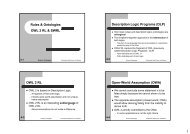A Review of Multi-Label Classification Methods - LPIS
A Review of Multi-Label Classification Methods - LPIS
A Review of Multi-Label Classification Methods - LPIS
You also want an ePaper? Increase the reach of your titles
YUMPU automatically turns print PDFs into web optimized ePapers that Google loves.
Table 6: Transformed data set using PT6Ex. l Y[l]1 Sports 11 Religion -11 Science -11 Politics 12 Sports -12 Religion -12 Science 12 Politics 13 Sports 13 Religion -13 Science -13 Politics -14 Sports -14 Religion 14 Science 14 Politics -1Luo and Zincir-Heywood (2005) present two systems for multi-label document classification, whichare also based on the kNN classifier. The main contribution <strong>of</strong> their work is on the pre-processingstage for the effective representation <strong>of</strong> documents. For the classification <strong>of</strong> a new instance, thesystems initially find the k nearest examples. Then for every appearance <strong>of</strong> each label in each <strong>of</strong> theseexamples, they increase a corresponding counter for that label. Finally they output the N labels withthe largest counts. N is chosen based on the number <strong>of</strong> labels <strong>of</strong> the instance. This is an inappropriatestrategy for real-world use, where the number <strong>of</strong> labels <strong>of</strong> a new instance is unknown.McCallum (1999) defines a probabilistic generative model according to which, each label generatesdifferent words. Based on this model a multi-label document is produced by a mixture <strong>of</strong> the worddistributions <strong>of</strong> its labels. The parameters <strong>of</strong> the model are learned by maximum a posterioriestimation from labelled training documents, using Expectation Maximization to calculate whichlabels were both the mixture weights and the word distributions for each label. Given a new documentthe label set that is most likely is selected with Bayes rule. This approach for the classification <strong>of</strong> a








